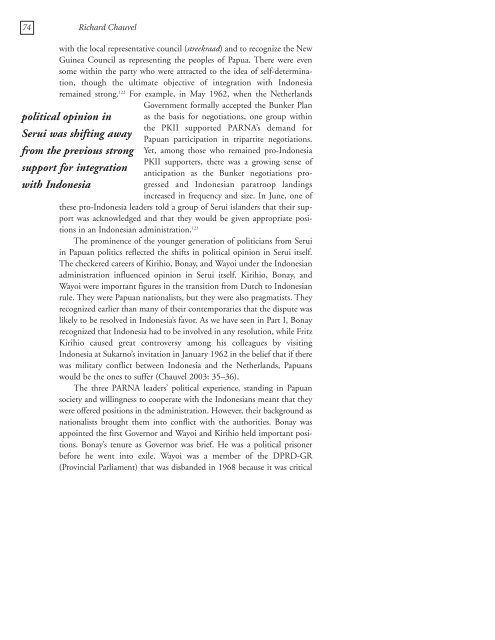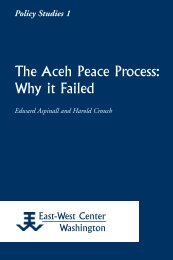Constructing Papuan Nationalism: History, Ethnicity ... - ScholarSpace
Constructing Papuan Nationalism: History, Ethnicity ... - ScholarSpace
Constructing Papuan Nationalism: History, Ethnicity ... - ScholarSpace
- No tags were found...
You also want an ePaper? Increase the reach of your titles
YUMPU automatically turns print PDFs into web optimized ePapers that Google loves.
74 Richard Chauvelwith the local representative council (streekraad) and to recognize the NewGuinea Council as representing the peoples of Papua. There were evensome within the party who were attracted to the idea of self-determination,though the ultimate objective of integration with Indonesiaremained strong. 122 For example, in May 1962, when the NetherlandsGovernment formally accepted the Bunker Planas the basis for negotiations, one group withinthe PKII supported PARNA’s demand for<strong>Papuan</strong> participation in tripartite negotiations.Yet, among those who remained pro-IndonesiaPKII supporters, there was a growing sense ofanticipation as the Bunker negotiations progressedand Indonesian paratroop landingsincreased in frequency and size. In June, one ofthese pro-Indonesia leaders told a group of Serui islanders that their supportwas acknowledged and that they would be given appropriate positionsin an Indonesian administration. 123The prominence of the younger generation of politicians from Seruiin <strong>Papuan</strong> politics reflected the shifts in political opinion in Serui itself.The checkered careers of Kirihio, Bonay, and Wayoi under the Indonesianadministration influenced opinion in Serui itself. Kirihio, Bonay, andWayoi were important figures in the transition from Dutch to Indonesianrule. They were <strong>Papuan</strong> nationalists, but they were also pragmatists. Theyrecognized earlier than many of their contemporaries that the dispute waslikely to be resolved in Indonesia’s favor. As we have seen in Part I, Bonayrecognized that Indonesia had to be involved in any resolution, while FritzKirihio caused great controversy among his colleagues by visitingIndonesia at Sukarno’s invitation in January 1962 in the belief that if therewas military conflict between Indonesia and the Netherlands, <strong>Papuan</strong>swould be the ones to suffer (Chauvel 2003: 35–36).The three PARNA leaders’ political experience, standing in <strong>Papuan</strong>society and willingness to cooperate with the Indonesians meant that theywere offered positions in the administration. However, their background asnationalists brought them into conflict with the authorities. Bonay wasappointed the first Governor and Wayoi and Kirihio held important positions.Bonay’s tenure as Governor was brief. He was a political prisonerbefore he went into exile. Wayoi was a member of the DPRD-GR(Provincial Parliament) that was disbanded in 1968 because it was criticalpolitical opinion inSerui was shifting awayfrom the previous strongsupport for integrationwith Indonesia
















